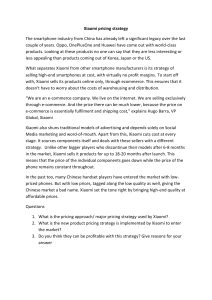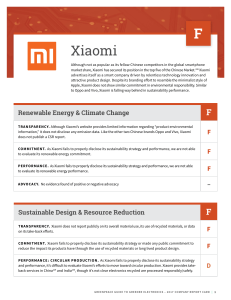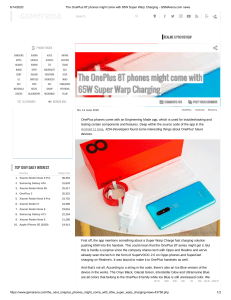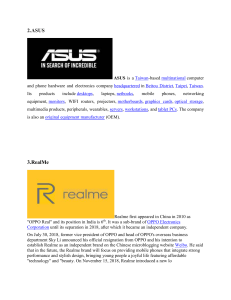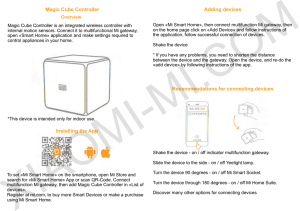Xiaomi Corporation: Challenges of Multinational Companies
advertisement
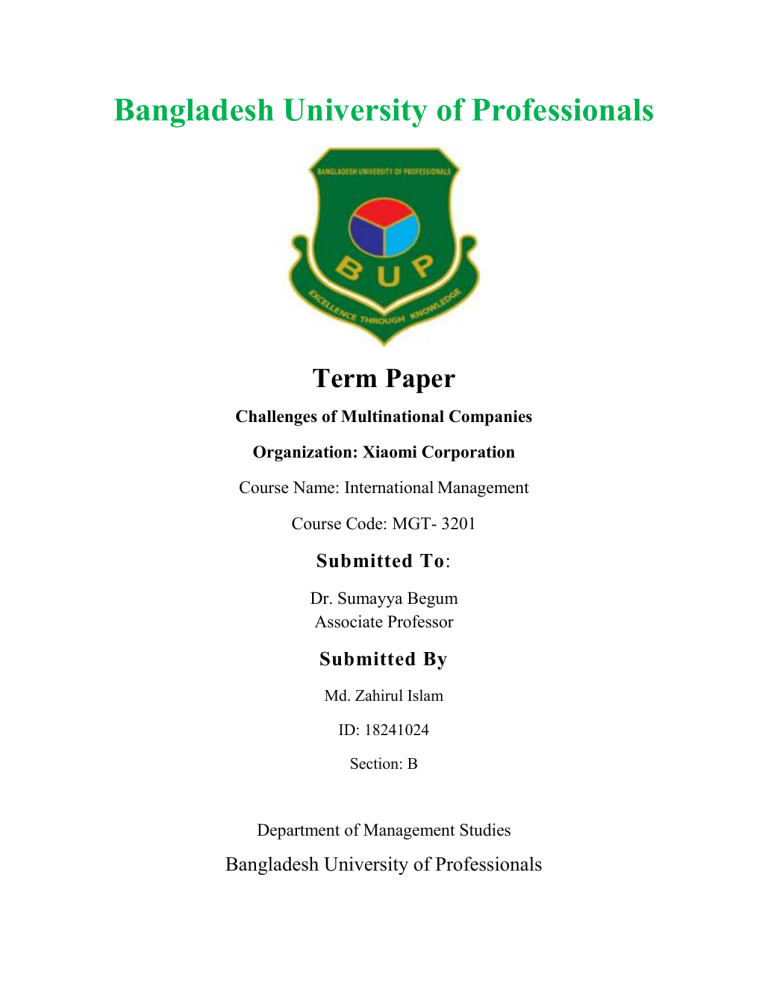
Bangladesh University of Professionals Term Paper Challenges of Multinational Companies Organization: Xiaomi Corporation Course Name: International Management Course Code: MGT- 3201 Submitted To: Dr. Sumayya Begum Associate Professor Submitted By Md. Zahirul Islam ID: 18241024 Section: B Department of Management Studies Bangladesh University of Professionals 30th November 2020 Dr. Sumayya Begum Associate Professor Bangladesh University of Professionals Subject: Submission of Term Paper. Dear Ma’am, I am hereby submitting my Term Paper, which is a part of the BBA Program curriculum and international management course. This Term Paper is based on, ‘Challenges of Multinational Companies based on Xiaomi corporation’. To prepare this report I have collected most relevant information to make this term paper more logical and reliable. I have tried my best to achieve the objectives of the report and hope that my effort will serve the purpose. I will be always available for answering any queries on the paper. Any sort of query or any criticism on this report will be beneficial for me, as it will give me the opportunity to learn more and enrich our knowledge. I hope you will consider the mistakes that may take place in the report in the spite of my best effort. MD. Zahirul Islam ID: 18241024 Section: B Department of Management Studies Bangladesh University of Professionals 2 Abstract This study aims to explore the challenges of multinational companies which they face in their business. The paper is covered by secondary data collected from research article, monographs, cases, and various published materials on the subject. The findings indicated that new challenges and existing opportunities for MNCs from the government, environment, Culture, political and legal issue. Overcoming the challenges are one of the most important issue to get successfully in businesses. This study also covers about the way to overcome those challenges in new globalization world. Summary This study contributes to the existing literature by analyzing conditions of Xiaomi corporation. From last 10 years Xiaomi doing their business almost all over the world. They reach 90 countries and have manufacturer plant outside china. All identified challenges and opportunities along with the hurdles are picked from the concurrent issues in multinational organization. Thus, the originality comes from logical linking among available factors behind globalization development scope in the world. 3 Table of Content Title Page Number INTRODUCTION 05 OBJECTIVE OF THE STUDY 05 Methodology 06 Limitations 06 Organization Review 07 Xiaomi’s Business Model 08 SWOT Analysis of Xiaomi 09-10 Challenges of Xiaomi Corporation in Host Country (China) 11 Political, Cultural, and Legal Challenges 12-13 Continent Based Challanges of Xiaomi 14-19 Strategies Xiaomi followed to Overcome all Challenges 20-22 Data Findings 23 Recommendation 23-24 Conclusion 24 References 25 4 INTRODUCTION Multinational company means that a firm that has operations in more than one country, international sales, and a mix of nationalities among managers and owners. And this happened because of globalization. Globalization means the process of social, political, economic, cultural, and technological integration among countries around the world. Globalization is distinct from internationalization in that internationalization is the process of a business crossing national and cultural borders, while globalization is the vision of creating one world unit, a single market entity. Evidence of globalization can be seen in increased levels of trade, capital flows, and migration. Globalization has been facilitated by technological advances in transnational communications, transport, and travel. But when a company want to expend their product or services into the global market, they face so many challenges to operate their business on other countries. Peoples are different according to their culture, environment, norms, religion etc. those peoples also have different types of needs and wants. And counties have their own economic system, political systems, regulatory issues to handle business. Those information are important for every MNCs to overcome their challanges and develop their business. Objective of the Study The objective of the study is to learn about the opportunities and challenges of global expansion in this case focusing on the fast-moving high-tech space. So that we should also be able to analyze the company’s business model and evaluate whether a model that succeeded domestically would also succeed internationally. 5 Methodology In order to carry on this work and to find out the objectives that will be quantitative in nature, descriptive research design has been tackled. Relevant and supporting secondary data have been collected through desk study, including research articles, texts, research monographs, cases, and various published and unpublished materials on the topic. These data have been examined in the basics of notable relationship to establish the study more enlightening and thought stimulating. Limitations There are some limitations of this paper. But these limitations represent only the facts that really hampered the quality of report. I did not have access to all types of recent data. Again, some site was restricted despite all these limitations, I have given the best of my efforts and tried to make the report as informative and as comprehensive as possible. There is high degree of variations in the available market statistics produced by different sources which often put the report in a dilemma on determining the level of authenticity of the data collected. 6 Organization Review Introduction of Xiaomi Corporation Xiaomi Corporation is a Chinese multinational electronics company founded in April 2010 and headquartered in Beijing. Xiaomi makes and invests in smartphones, mobile apps, laptops, home appliances, bags, shoes, consumer electronics, and many other products. Xiaomi is also the fourth company in the world after Apple, Samsung, and Huawei to have self-developed mobile phone chip capabilities. Xiaomi released its first smartphone in August 2011 and rapidly gained market share in China to become the country's largest smartphone company in 2014. On July 2013 Xiaomi announced Redmi is a sub-brand owned by Xiaomi. became a separate sub-brand of Xiaomi in 2019 with entry-level and mid-range devices, while Xiaomi itself produces upper-range and flagship Mi phones. At the start of second quarter of 2018, Xiaomi was the world's fourth-largest smartphone manufacturer, leading in both the largest market, China, and the second-largest market, India. Xiaomi later developed a wider range of consumer electronics, including a smart home product ecosystem, which has connected more than 100 million smart devices and appliances. In 2014 Xiaomi announced its expansion outside China, with their first international headquarters in Singapore. In August 2016 Xiaomi entered Bangladesh via Solar Electro Bangladesh Limited. In May 2017, Xiaomi opened two MI Home stores: one in Bangalore (India) and one in Bangladesh. It is the first of several planned for the region. Xiaomi has 16,700 employees worldwide. It has expanded to other markets including Greater China, Singapore, Japan, South Korea, Russia, South Africa and most countries and regions in Southeast Asia and Europe. According to recent reports from the head of Xiaomi Corporation, India, the company has 7 factories in India and these factories produce more than 99% of Xiaomi phones in India. While crucial markets like India were consistent, with the company enjoying a healthy 26% of the market share, it was Europe where Xiaomi saw the maximum amount of growth. According to a report by Canalys, Xiaomi was the fifth-largest smartphone vendor in Europe. It managed to ship 5.5 million smartphones in Q3 2019, netting it a 10.5% market share and placing it right behind Apple, albeit with a wide margin between them. 7 Xiaomi’s Business Model The main reason of this company to be successful is that they are making product with good features and selling them into an unbelievable law price. The company was launched in 2010 and they have achieved an incredible success in such a short period of time. By 2014 they were the leading smartphone manufacturer by number of sales in china. We usually complain about how phone price is going up, but we don’t usually understand the hidden cost the phone requires before reach to our hand. Companies spend billions just to let us know that they exist or keep us aware of their latest product. But end of the day we the consumers have to pay for that. However, Xiaomi has found ways to sell its products at unbelievable law price. Instead of having multibillion-dollar marketing budget the company does very little advertising and relies on social media. And to reduce the cost further they don’t spend opening up stores around the world and hiring thousands of people and sell their products online directly to customers. By cutting out the middleman the company could further lower their pieces. Their logic is to build great phones for extremely affordable price that would simply attract everyone. Xiaomi sells their Smartphone nearly their cost of production and make 5% profit. But they have a completely different business model. Instead of making huge profit they sell us the product, they would rather make a profit when we use the product by selling service, ads and so on. Besides just selling us services Xiaomi sells like everything. They are selling different types of products like laptops, bags, electronic scooters, TV etc. 8 SWOT Analysis of Xiaomi Strengths One of the biggest Smartphone makers – Xiaomi is one in all the biggest smartphone manufacturers within the world. it’s aforesaid to be the fifth largest smartphone manufacturer as of 2017. Originating from China, the Smartphones area unit factory-made in large quantities and have wide acceptance across the globe. Highest commercialism Smartphone – The REDMI Note four became the best commercialism smartphone in Asian country and China and much in five hundredth of the Asian market. This shows that Xiaomi is powerfully rising within the smartphone market and has already overwhelmed many giants. Huge China and Asia market on the market – Another profit to Xiaomi is that the total Asian market is their playground. As China lies inside Asia and as Chinese mobile brands area unit extremely penetrated within the Asian markets, Xiaomi still features a ton of ground to explore. Penetrative rating – Xiaomi has the strongest penetrative rating advantage as a result of it typically uses marketing techniques and avoids dealer and distributor margins. Weaknesses Offline Distribution – Xiaomi principally sold through the flash sale but generally, it completely was difficult for patrons to urge their hands on a REDMI or MI model phone. this may be as a result of their offline distribution is not up to mark and Xiaomi phones sell principally via E-commerce. Brand image and Equity – as a result of the advertising and mercantilism efforts unit poor, the entire image is not so good as Samsung or Apple or various such competitors. the merchandise portfolio of Xiaomi is in addition restricted that a lot of effects the entire image. Service centers too unit restricted and each one these factors contribute to the low whole equity and name. Low Skimming value – whereas various smartphone manufacturers survive on skimming value, Xiaomi launches its own phones at low prices among the flash sales. As a result, it cannot build 9 the foremost of the skimming value or the advantage is not as profitable as a result of it’d be for Samsung or Apple or various such high-end brands. Opportunities Expansion – Covering the developing countries and also the rising markets ought to be the priority for Xiaomi. because it principally follows on-line sales model, that is changing into standard in several countries, it ought to expand to countries wherever E-commerce mode of purchase is well established or within the method of firm. Distribution – Besides on-line distribution, Xiaomi conjointly has to consider offline distribution if it ever needs to be consistent like a number of its prime competitors. Offline distribution would conjointly mean higher expenses and so an increase in worth. however it’ll facilitate the complete to form a long image and equity. Brand Building – complete building ways like ads, Trade promotions, ATL campaigns and BTL campaigns ought to be launched as frequently as attainable to make a more robust complete image. Xiaomi is way behind Oppo and Vivo wherever BTL Campaigns area unit involved. Product Portfolio – Product portfolio of Xiaomi is proscribed and it’s two major series that truly contribute to the whole revenue of the complete. Threats Competition – Oppo, Vivo, Realme area unit three of the largest competitors for Xiaomi as a result of their themselves from China and have a similar producing benefit like Xiaomi. Besides this, Oppo and Vivo have a robust offline presence and have immense distribution network. Thus, they’re an enormous threat to Xiaomi. Service – the dearth of service centers cherishes the amount of sales by the complete could be a worrying datum. Xiaomi has to increase its sales and repair centers each if it needs to retain its customers. Brand Differentiation is absent – The smartphone section has become such complete differentiation is changing into terribly troublesome. every complete is arising with product that area unit nearly similar, thereby creating it troublesome for the client to decide on one complete over alternative. this can become particularly troublesome once additional and additional brands come back from China. 10 Challenges of Xiaomi Corporation in Host Country (China) With the intense development and growth of China's mobile communication and technology industry, many manufacturers have come up to take the advantage of growing market of mobile phone users. Approximately 1 billion people own a smartphone. This has led to birth of many of the world’s famous mobile phone brands. One of the major brands, emerged in 2010 was Xiaomi. Xiaomi has become one of the most valuable startups from valued currently at US 50 Billion Dollars. It made huge success in the smartphone selling business by implementing mix market strategies which have proven highly successful in the global as well as domestic markets. This organization overcome different kind of challenges to become number one brand of their host country. Some challenges they faced in china are: Similar Products: At the beginning of their journey they basically made smartphones just like providing similar features of Samsung or iPhone. That was their one of the main weakness on that time. But they overcome this problem vary easily by selling those smartphones at a law price. Durability of Product: As Xiaomi came to the market suddenly and started to make high features smartphones then the users started to think about is it long lasting or poor-quality smartphone. But Xiaomi successfully proved that their devices are long lasting and have a good quality chip capability Distribution: At the beginning Xiaomi only sell their product on online platform in China. But in time they thought that they must reach all over China, and they want to be the number one smartphone brand in China and then they started to set up MI Store all over the China to distribute their phones and service. Production of different of product: After being successfully become a smartphone brand Xiaomi started to produce different types of product like laptop, mobile apps, home appliances, bags, shoes, consumer electronics, and many other products. And the customers are accepted Xiaomi’s different type of product. 11 Political, Cultural, and Legal Challenges Political, cultural and legal challenges are available in every country. As a smartphone industry Xiaomi must need to overcome those challenges. Political: The role of political factors in the context of international business has become increasingly significant in the 21st century. Higher government and regulatory oversight of technology firms have made it evident. It was also evident in the Huawei ban that governments are now highly aggressive in terms of their control of technology firms whether domestic or foreign. Several more tech businesses like Facebook and Google have also faced significant problems in overseas markets caused mainly by regulatory issues. The Huawei ban and the China-US trade wars are also a sign that governments and regulatory agencies are going to play a more significant role in the area of international business. In the smartphone industry as well, the level of regulation and political control are growing higher. The trade war between the US and China is affecting nearly all the large technology firms in the US and China. Just because of political challenges Xiaomi still struggling to grow their market. Culture: Cultural differences one of the kye challenges to understanding customers. The development of cultural dimensions is based on Hofstede’s studies. The idea was to compare cross-cultural differences. The first Hofstede’s cultural dimension is power distance. It is the extent to which less powerful people in a society expect and accept that power is distributed unequally. The second dimension of national culture is uncertainty avoidance. It is the extent to which people tolerate ambiguity and risk or feel threatened by change. The third dimension is individualism, as opposed to collectivism. It is the extent to which people are integrated into tight social networks and act on the basis of their own needs or the needs of their social groups. The fourth dimension along which national cultures differ systematically is masculinity, with its opposite pole femininity. According to Hofstede, the duality of sexes is a fundamental fact with which different societies cope in different ways. The fifth concept that Hofstede found later is long vs. short-term time orientation, which focuses on the degree the society embraces, or does not embrace, long-term devotion to traditional values. China has high long-term time orientation index. Long-term rewards expected as a result of today’s hard work. So the cultural impact is one 12 of the key factor to identify the place of business. This is one of the main challenge of Xiaomi to establish their business. Legal: Law and legal factors are now of paramount importance in the entire technology industry for successful global operations. Government control and oversight of technology firms, including smartphone brands, grew due to several factors. On the one hand, while the growing influence of tech businesses worldwide is an essential concern for governments, on the other, emerging concerns like consumer privacy and data security have also given rise to the need for higher scrutiny. Focusing on compliance is vital for operating successfully in various regions around the globe. It is why the smartphone companies have dedicated compliance teams that focus upon complying with local laws in the areas where the business operates as well as international laws that influence the firm’s business. Some of the standard rules that affect large and global enterprises include labor laws, product quality laws, environmental laws, and data security and privacy laws. Patent laws and some other laws also affect smartphone firms. For the smartphone brands like Xiaomi, it is necessary to comply with these laws to avoid incurring hefty fines inflicted by the government or regulatory agencies. Apple, among other leading technology firms in the US, faced an antitrust probe. In a tax-related case in the EU, Apple paid around $15 billion. The different income tax structures in various regions, as well as the evolving legal framework in the Asian markets and the US, also give rise to troubles for the leading tech firms whose size makes them a frequent target of government action. 13 Continent Based Challanges of Xiaomi Asia After successfully completing the China market Xiaomi started to sell their product globally and they start with Asian region. Xiaomi targeted Asian developing countries to achieve their goal. At first, Xiaomi sold smartphones over online or via some corporation but later in May 2017, Xiaomi opened two MI Home stores: one in Bangalore (India) and one in Bangladesh. It is the first of several planned for the region. Xiaomi has second-largest market in India and become much popular in Bangladesh. the company has 7 factories in India and these factories produce more than 99% of Xiaomi phones in India. On 20 February 2017, Xiaomi officially launched in Pakistan and brought its Mi and Redmi Note lineup to the country. In this region Xiaomi faced different kind of challenges, some of them are: International Recruiting: As Xiaomi setup factory in India and setup MI store in different countries in Asia they started to recruit local employees. That was their one of the most important challenge to recruit right employees to get the desire output. Marketing Strategy: As Xiaomi follow a unique marketing strategy to save their cost so that was their one biggest challenge to do effective marketing in this region. That is why Xiaomi read the market on this region and they found that some of the Asian countries are developing vary fast, and peoples are too much connected on internet and social media. So, they started to make some ad on social media and they successfully manage to attract customers. Liked by 2.56 million people, the Facebook page of Xiaomi Bangladesh served as the main social media channel for promotion and public communication. Keeping a pace at two or three new updates on Facebook each day, the number of ‘likes’ and ‘comments’ is around 2,000 on average. Distribution in Bangladesh: As Xiaomi still not started their local production in Bangladesh, they are selling their smartphones on online. For online distribution, the company partnered with local e-commerce platforms DealBazaar and Gadget and Gear to 14 manage online services. But they faced some problems regarding this online method and doing so on May 2017, Xiaomi opened MI Home stores in Bangladesh. For the offline channel, offline Mi stores and Shwapno outlets are the right places to look into. Among the 64 districts in the country, Mi store covers 58 districts, depicting a complete coverage and localization in distribution. In addition, the partnership with Shwapno outlets would further assist in Xiaomi’s in-depth sales throughout the country. Tax Issue: Bangladesh government set a huge rate of tax to import mobile and other electronics devices to attract those MNCs to start local production in this country. So, the smartphones companies have to pay approximately 57% tax to import their phones. That’s why Xiaomi only import mid-range smartphones in Bangladesh but still they set the price vary carefully so that people can be satisfied. Local production: As Xiaomi facing the problem with the tax issues the decides to set up local production. Xiaomi already set up 7 factories in India and these factories produce more than 99% of Xiaomi phones in India. To boost local production, since 2017 the government of Bangladesh has been offering some tax benefits to local assemblers and increased import duties. Though they official announcement that Xiaomi is going to set up its local production in Bangladesh. Competitors: Competitors of Xiaomi like OPPO, vivo, Realme and Samsung, have already contributed to local manufacturing development. Besides the policy issue, local production offers great help in smoothing the inventory and sales flow when there is a steep change in local demand. Xiaomi still lack behind in this part, but they are trying to overcome from it. Cultural and Human Resource Challenges: Xiaomi have 18,170 employees all over the world. In Asian continent peoples follow their culture in their own way and to mange the human resources Xiaomi face challenges to overcome it. Xiaomi still working on it, try to analysis to culture to understand employees and their customers. 15 Europe After successfully develop their brand in Asian counties, Xiaomi started to focus on Europe countries. In September 2016 Xiaomi's smartphones became officially available in the European Union through their partnership with ABC Data. Xiaomi initially spread its wings just in Eastern European countries, where money has traditionally been a bit tighter, and where budget smartphones make good sense. It started in Poland in September 2016 via a first distributor. Then the company set its sight to the more mature markets to the west. By November 2017, Xiaomi had put up two stores in Spain. Then came rapid expansion: 50 stores across Western Europe by end 2018, including flagship stores, such as the UK store opened in London’s Westfield shopping center in November 2017. Xiaomi still facing few challanges over there: Distribution: Xiaomi set up MI stores over in Europe but those are not enough to cover those countries. There are still no stores yet in Germany, but official stores did appear in Rome, Porto, and Bucharest in 2019, while Paris has Xiaomi’s largest store in Europe. Local Production: Xiaomi still not started their local production on this continent. Where other companies already set up factories over there. Competition with established Brand: Europe already have three established brand 16 Samsung, Huawei, and Apple. Xiaomi still competing with those well-developed brands to become one of the best brands in Europe. With Huawei floundering in a state of limbo created by a mix of political maneuvering and obscure national security issues, Xiaomi appears to sense its opportunity and is putting its foot to the floor. The Beijing-based company hasn’t been taking on the likes of Apple/Samsung/Huawei at the premium end of the European market, but don’t rule it out. For now, we see Xiaomi coveting the middlerange market. Its German launch event was, as mentioned, actually for a mid-range device in the value-focused Redmi sub-brand. That fits where Huawei was previously making considerable progress in Europe, in large part through Honor. 2020 is poised to be a tough one, with upstart OEMs like Realme coming in strong. While Huawei’s struggles leave a gap in the market for all players to grow their market share, Xiaomi will have to ensure it can offer a range of 5G equipped hardware at multiple price points to make sure it doesn’t lose out. Additionally, we can expect the company to continue its expansion into new markets within Europe and beyond. 17 Africa Xiaomi, the China-based smartphone maker is among the leading companies in its home market. In Asia, the company is dominating the market, dethroning South Korea-based Samsung. Now, the company is keeping its eyes on Africa. The challenges Xiaomi is facing in this region: Disturbing: Xiaomi faced this kind of challenges before in different region and In a new corporate restructuring, Xiaomi has decided to set up a business headquarters in Africa as the company is looking to boost its smartphone sales in the region. To boost up sales of its products in Africa, the company become partner with Jumia Technologies, which is a leading pan-African e-commerce operator. Market Segmentation: Xiaomi face that higher budget smartphones are not much popular in this region, so they decided to sell Redmi phones as their sub-brand in this region. This brand only provides mid-range smartphones. Sales Strategy: Xiaomi tried to boost their sales by using e-commerce platform but without offline store they are facing difficulties. Because other brands are selling smartphones by using offline stores. So, Xiaomi is also expected to deploy an offline sales strategy and will be granting distribution rights of its handsets in Africa to China-based integrated platform service provider Shenzhen Keting Digital Technology. 18 America Xiaomi is the fourth-largest seller of smartphones in the world, according to Gartner, behind Samsung, Apple and Huawei. Its IPO could raise $10 billion, potentially valuing the company at $100 billion and making it one of the largest IPOs since Alibaba. One of the world’s largest phone brands is preparing for one of the largest IPOs in years — but it may find it very difficult to sell its products in the American region. Xiaomi hopes to enter the U.S. one day, according to comments made to CNBC. Here’s why that won’t be easy. Xiaomi still not started to selling smartphones in this region, but they are selling electronic product to monitor the market demand as well. In American region they are facing unavoidably challenges which make then to think twice before starting their business over there. USA phone market: American phone markets are based on some well-known brands like Apple, Samsung and Huawei. So mid-range smartphones are not going to work in this region. Peoples of this region already habituated with existing brands. Looming trade war with China: There is looming trade war with china with this region form long time. U.S government already ban so many china’s owned application on their countries. As long this war will not be finished Xiaomi will not get their freedom to doing business. Extremely hard to establish carrier partnerships: As there is a secret war happening between America and China no companies are not interested to be the partner to supply smartphones there. Branding: Because of Xiaomi did vary little marketing over last 10 years they sale products but making a famous brand like Samsung and Apple. Xiaomi isn’t well-known in the United States. While it has made a name selling good phones at low prices in other markets, consumers in the U.S. don’t know that yet. 19 Strategies Xiaomi followed to Overcome all Challenges From last 10 years Xiaomi following some strategies to overcome all challenges. So that they become a successful smartphone industry in the world. The company’s growth is more remarkable when you see how it does so many things very differently from more established phone brands. But the case may be that those quirks are Xiaomi’s secrets to success. Here is Xiaomi’s 10 business strategies which make then success and overcome all challenges: 1. Xiaomi is basically an e-commerce company: Xiaomi co-founder Lei Jun likes to say that his newest startup is an e-commerce company – which is one of many reasons he dislikes the frequent comparisons between Xiaomi and Apple. He thinks that likening it to Amazon is closer to the mark. Xiaomi has its own e-store and also has a storefront on Alibaba’s Tmall. The numbers back up Lei Jun’s claim. Xiaomi’s website is the third largest business-toconsumer (B2C) ecommerce store in China in terms of sales volume. Xiaomi generally only sells its devices in limited flash sales – typically in batches of about 50,000 to 100,000 in China, but in smaller amounts overseas – so as to ensure it only manufactures what it’s sure to sell. The upstart company’s sales pitch doesn’t stop once someone has bought a smartphone. New customers will find that their phone comes with a Xiaomi store app pre-installed. 2. Homepage is an e-store: That online commerce focus finds its apotheosis in the Xiaomi.com website. Most gadget brands use their homepages as showrooms or glorified online adverts. Xiaomi, however, cuts to the chase by making its home on the web into a pure ecommerce store. “Xiaomi’s product pages mimic best practices from T-mall,” says Rand Han, the founder and managing director of Resonance China. Tmall is China’s biggest brandoriented online marketplace, with tens of thousands of vendors such as Uniqlo, Costco, and Burberry. That makes Xiaomi’s website layout familiar to the hundreds of millions of shoppers on Tmall and other popular ecommerce sites in China, with the usual tabs to switch between images, specifications, and buyers’ reviews and ratings. 3. Makes use of a new kind of social commerce: Because Xiaomi largely sells its phones online, social media is an important part of the way it remains visible and engaged with both 20 customers and prospective buyers. It does this in China mainly via Weibo, and in new markets it’s making use of Facebook, Twitter, and – primarily through Hugo Barra, exGoogler turned Xiaomi VP for international operations – Google+. 4. Every product range has a social hub: Another crucial part of Xiaomi’s social media strategy is that it runs Weibo accounts for every product range. Xiaomi has 10 main Weibo accounts, the most popular of which is the Xiaomi Mobile Weibo with close to 11 million fans; the newest one, for the MiPad (pictured above), has just surpassed 500,000 followers. Xiaomi’s corporate Weibo has four million followers, indicating that people would rather interact online with gadgets (so to speak) rather than a company. Gadgets are very personal, but companies tend to be rather faceless, so this makes sense from a human perspective – yet it’s something that so few companies do, particularly outside of China. 5. Creates scarcity: Xiaomi’s flash sales help it rein in inventory and reduce wastage, avoiding the kind of over-production disasters seen recently with Amazon’s Fire Phone and Microsoft’s Surface RT. While that makes it harder to get a Xiaomi gadget, the company has managed to spin that into a positive, creating periodic hype as flash sales of a limited number of devices open up each week. Xiaomi’s social media accounts, particularly on Weibo and WeChat, play a key role in driving people to the registration page for each new flash sale. 6. Offline is secondary to online: Xiaomi has 451 national service centers, but they’re not stores – although they do look rather a lot like Apple’s iconic shops with their pine desks and lots of space for playing around with the gadgets. These relatively small shops usually just outside of a city’s main shopping area save Xiaomi spending on premium retail real estate. When Xiaomi ventures offline such as with events or its service centers it’s all very much secondary to its ecommerce core. 7. Lowers the price of “premium”: Xiaomi first emphasizes its low price prior to diving indepth into its flagship product’s high level of integrated technology and hardware 21 performance. This combination of low cost and high value is a strong message to Chinese consumers. Inspired by Apple, Xiaomi also educates consumers on its design philosophy, emphasizing a focus on simplicity and functionality in its products. 8. Runs its own community: Along with its careful social media stratagem, Xiaomi is also pro-active in running its own community forums, or BBS. This is where the brand’s most hardcore fans, dubbed “Mi fans,” meet to discuss gadgets, share knowledge, and generally hang out. This is something common to Chinese companies, but largely unused by major brands overseas. 9. Loyalty program: Lots of supermarkets and quite a few other retailers now have loyalty programs, but it’s not something that people associate with gadget brands. Xiaomi, however, has a well-established program under the VIP Users Center part of its BBS. Being a Xiaomi VIP entails getting points with each new purchase, which counts towards your status in the Xiaomi online community as well as for discounts on future purchases. VIPs can also opt into participating in online “missions” and special events offline. 10. Beta access to gadgets: For some gadgets, Xiaomi takes on a limited number of beta users typically just 500 – who can buy the gadget for RMB 1 (US$0.16) and a few hundred BBS loyalty points ahead of its official launch. Shortly after Xiaomi teased its MiPad in May, selected Xiaomi fans got hold of the Android-based tablet a few weeks before it hit Xiaomi’s online sales. The strategy here is clear – to build up hype and word-of-mouth advertising in the time it takes for the first batch of devices to roll off the production lines. It’s usually a period when a newly revealed gadgets drops off the radars of most gadget enthusiasts, but Xiaomi keeps people tuned in until the first flash sale is ready for pre-registration. 22 Data Findings The significant part I found when I had prepared this paper that Xiaomi has no quality and compliance issue regarding anywhere in the world. They always focus on the quality of the product and give the customer what is called the best product at a reasonable price. Like any global business, Xiaomi corporation must manage wide-ranging commercial and competitive pressure to deliver increased financial returns and growth. At the same time, they are accountable for their employees and have a responsibility towards the workers in their suppliers' factories and also for the environment. Within the global business landscape of the smartphone industry, Xiaomi is continually confronted with a variety of challenges that arise from our commitment to striking the balance between shareholder interests and the needs and concerns of employees and workers and the environment, or in short in our aim to become a successful company. Recommendation In today’s competitive world, organizations need to use marketing techniques and marketing expert research to continue their existence. However, the topper forming companies in different industries attempt to keep their customers and build customer satisfaction: hence, companies and sellers must follow various management strategies to improve marketing strategy. In the first stage, Xiaomi must use the entire potential of distribution to inform customers and improve their awareness of satisfaction and market performance; therefore, increasing distribution is essential. In the second stage, Xiaomi must use price promotion to raise awareness of satisfaction and stimulate customers. Particularly, price promotion encourages Xiaomi brand switching and provides customers incentives to test those smartphones. Xiaomi must do is improve other core competence for increase the shipments, thus strengthen the bargaining chips with the authorizer. In long run, Xiaomi Company must emphasis on independent innovation, although this move will cost a lot of time and money in the initial period, Xiaomi has to do so. Because there are no well-known companies who do not have their own core technology in the world. Core technology is the only way that one company must take to develop into a well-known one: To be 23 specific, firstly, the company must put emphasis on technological innovation and increase investment in research. To improve the after-sales service, firstly, set up enough online communities and forums, direct phone hotlines, ensure consumer advisory and solve the common problem of Xiaomi phone. Second, set up more direct sales service points and Xiaomi Home in big and medium sized cities can help to ensure the timely maintenance of Xiaomi phone; Corporate with local retail outlets in small cities in order to service rural customers and repair the phone. Then, in order to provide excellent service, Xiaomi has to keep improving employees' service awareness and carry out a full range of training for repair shop staff to improve their service quality; service centers should competitive with each other and set up a range of key performance indicators to ensure the quality of service. Xiaomi Company will set up online communities, direct sales service points, Xiaomi Home and other localized activity; it can’t avoid recruiting local people, which will relate to cross-culture management of employee. Xiaomi must train for overseas employee; explain characteristics and specifications of company’s culture, but do not force it to accept all. Also requires the management of Xiaomi Company to actively organize employees from different cultural backgrounds to communicate effectively within the company. Conclusion This study systematically discusses what the problems of Xiaomi company operate in different region, what cause those problem, presented alternative solutions and recommended solution at last. In a word, to increase the brand awareness, localize Xiaomi’s core competence in the world and reliance on mobile internet and social media, in world market. In order to solve the patent issues. In short run, it can’t avoid paying the license fee. Long-run Xiaomi Company must emphasis on independent innovation, to improve the after-sales service, firstly, set up enough online communities and forums, second, set up more direct sales service points and Xiaomi Home in big and medium sized cities. Above solutions suitable for Xiaomi Company, it also may be suitable for others China company which wants to expand the world market. There is no standard method to solve every problem, administrators should take care of it. 24 References A Case Study on Marketing Strategy of Xiaomi (September 2019). Retrieved from https://www.researchgate.net/publication/336551904_A_Case_Study_on_Marketing_Strategy_of _Xiaomi AGGASARA. (2019). A study of Marketing Mix Strategy ofXiaomi Mobile. Bhutani, D. (2020). Xiaomi in 2020: Up for the challenge. Andorid Authority. Retrieved from https://www.androidauthority.com/xiaomi-2020-1070341/ Cheap Jewelry Us. (n.d.). Retrieved from CHALLENGES FACED BY XIAOMI: https://cheapjewelryus.com/challenges-faced-by-xiaomi-xiaomi/ Doh, F. L. (2018). International Management . New York: McGraw-Hill Education. Haselton, T. (2018). Xiaomi will have a hard time selling phones in the US. CNBC. Retrieved from https://www.cnbc.com/2018/05/03/xiaomi-will-have-a-hard-time-selling-phones-in-the-us.html Kai-Sheng, L. (2018). The Problem Faced and the Solution of Xiaomi Company in India. International Journal of Advances in Management and Economics. Retrieved from https://www.managementjournal.info/index.php/IJAME/article/download/126/125 Perrot, F. (n.d.). Organizational Challenges of Multinational Corporations at the Base of the Pyramid: An Action-research Inquiry. Retrieved from https://www.researchgate.net/publication/278618703 Rayner, T. (2019). Huawei’s loss is Xiaomi’s gain in Europe. Retrieved from https://www.androidauthority.com/huaweis-loss-xiaomi-europe-1039797/ Russell, J. (2018). Xiaomi takes aim at Europe’s smartphone markets. TechCrunch. Retrieved from https://techcrunch.com/2018/05/07/xiaomi-europe/ Tanja Walsh, P. N. (n.d.). Cultural differences in smartphone user experience evaluation. Retrieved from https://www.researchgate.net/publication/221342529 Wikipedia. (2020). Article . Retrieved from https://en.wikipedia.org/wiki/Xiaomi Xiaomi. (2020). Retrieved from https://www.mi.com/global/ Xiaomi. (2020). MI Bangladesh. Retrieved from https://www.mi.com/bd/ Xiaomi. (2020). Mi India. Retrieved from https://www.mi.com/in/ Xiaomi’s Globalization Strategy and Challenges, SM262 (2016). Retrieved from https://www.gsb.stanford.edu/faculty-research/case-studies/xiaomis-globalization-strategychallenges 25
